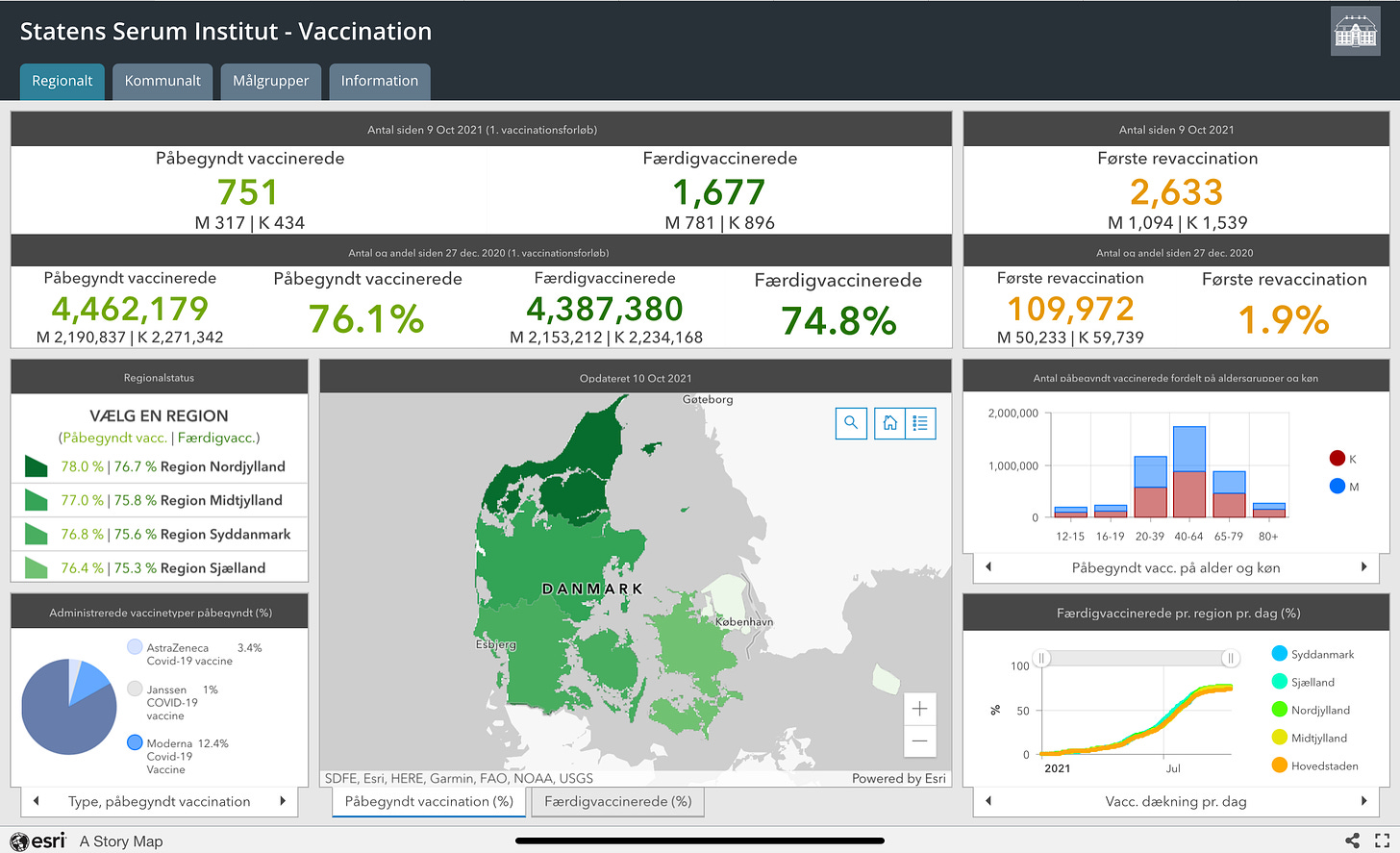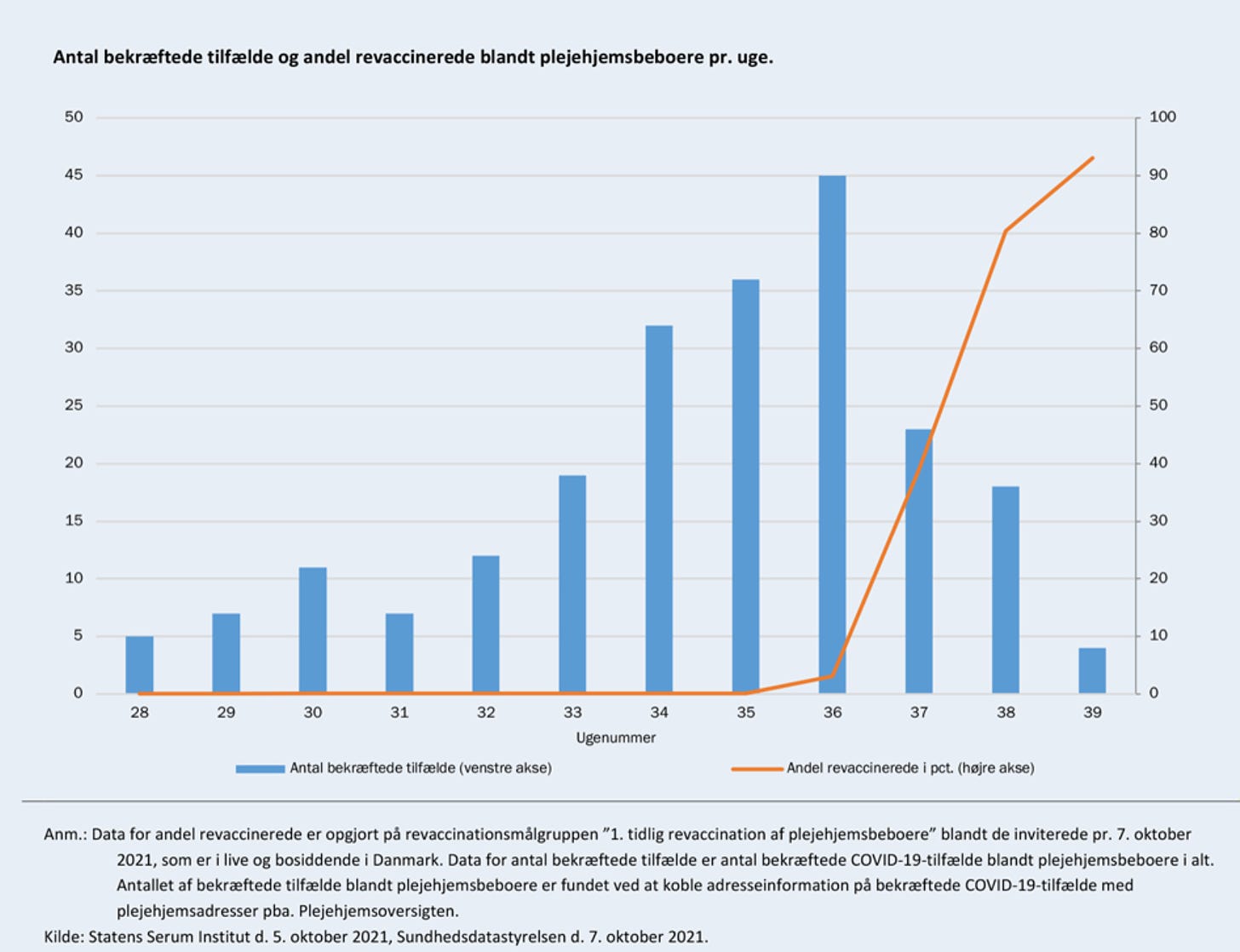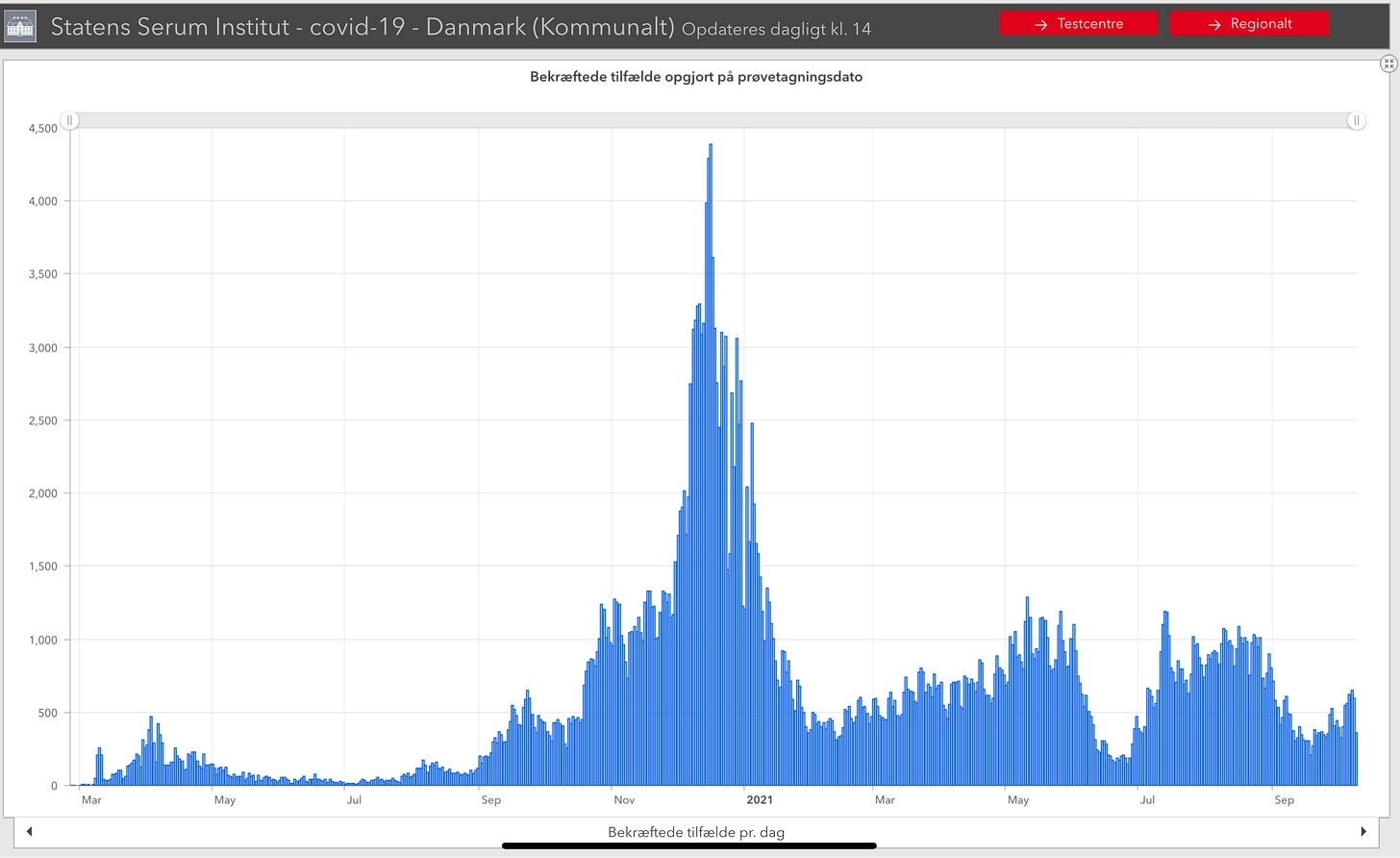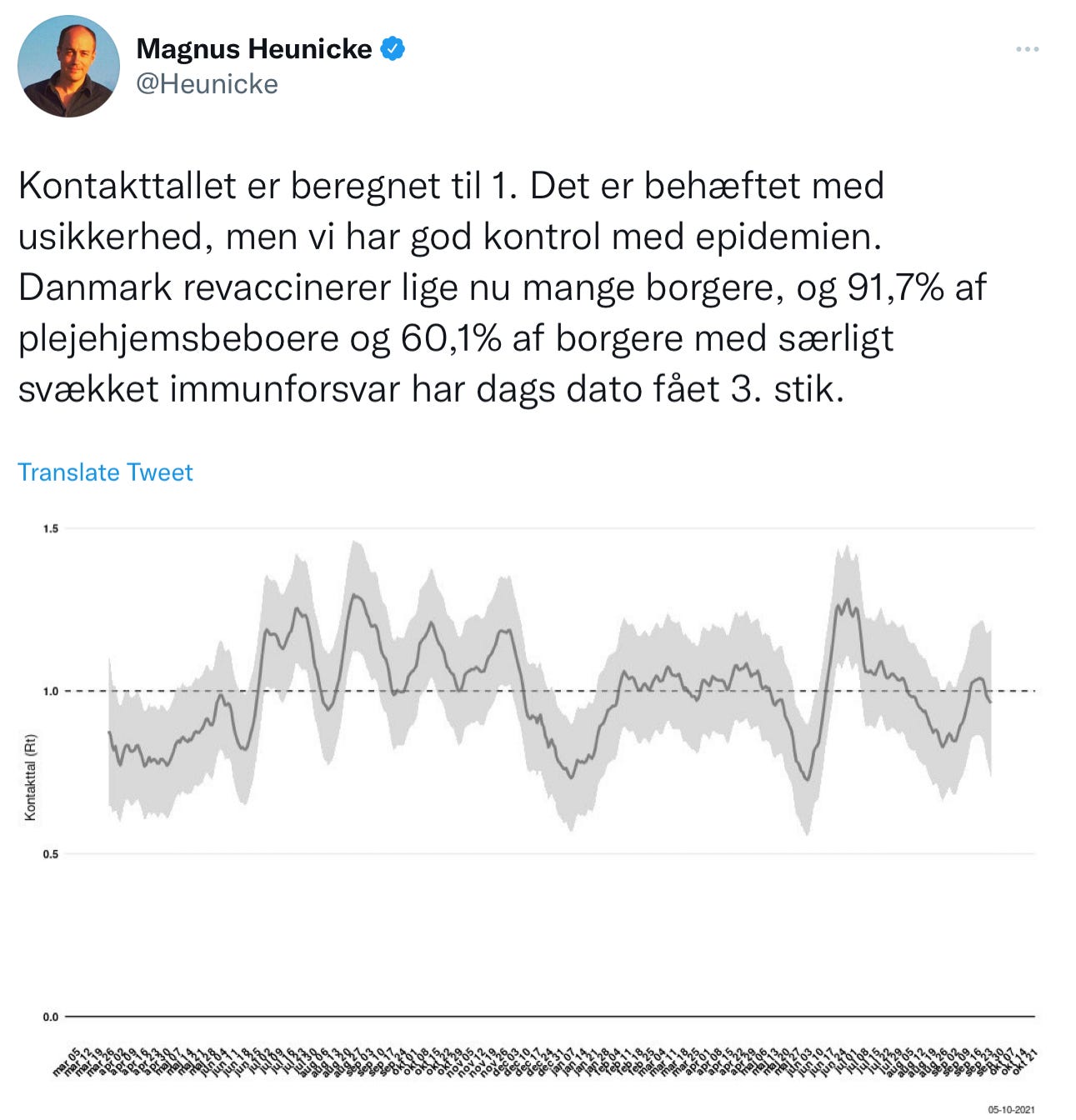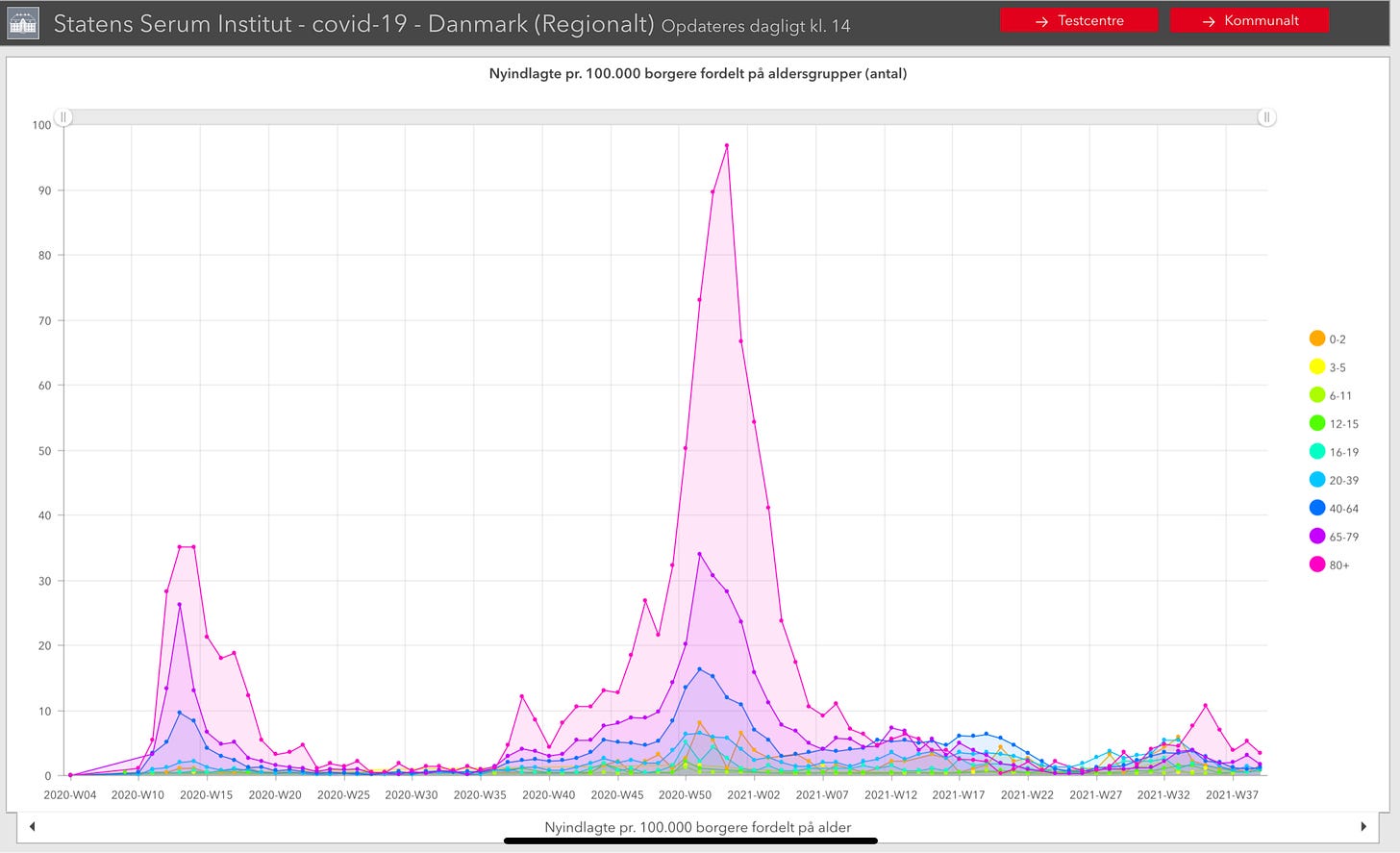Monday Morning News & Notes
All four Nordic countries curtail use of the Moderna vaccine among young people
🇩🇰🇸🇪🇫🇮🇳🇴
Use of the Moderna vaccine has been paused among young people in all four of the Nordic countries. This comes after a study covering Denmark, Finland, Norway, and Sweden examining any link between vaccines and a rare side effect impacting the heart. According to the Danish National Health Board, preliminary data from the as yet unpublished study found a “suspicion of an increased risk of heart inflammation” after Moderna vaccinations, especially after a second dose.
There have been rare cases of myocarditis and pericarditis after vaccination. The data from the Nordic study found the risk of the rare side effect was heightened among young people, especially men and boys under 30.
Danish National Health Board Unit Manager Bolette Søborg:
“In Denmark, we have not seen many cases of myocarditis, or that there should be any difference between the two vaccines in the Danish vaccination program. Both are extremely effective and we see a few, and in the vast majority of cases mild, of what are considered well-known side effects. At the same time, we in Denmark are in a slightly different situation than they are in our two neighboring countries.”
Denmark has primarily always used the Pfizer/BioNTech vaccine, not Moderna, for young people aged 12 to 17 years old. Instead of any major change, it will simply continue to stick with Pfizer for vaccinating young people.
In Sweden, use of the Moderna vaccine has now been paused for anyone 30 years old or younger, or anyone born in 1991 or later. The Swedish Public Health Agency says the decision was made for precautionary reasons.
The agency also notes there are about 81,000 people 30 years old or younger who have had one dose of the Moderna vaccine but not a second. It says discussions are ongoing to determine the “best solution” for those people.
In Norway, use of the Moderna vaccine for those 18 years old and younger has also been suspended. But for men 19 to 30 years old, the Norwegian Institute of Public Health is instead recommending they not use the Moderna vaccine and stick to Pfizer instead.
In Finland, the Pfizer vaccine is now mandated for all men and boys between the ages of 12 and 30 years old. However, women of all ages in Finland can still be vaccinated using Moderna. The Finnish Institute for Public Health says the risk of myocarditis and pericarditis is clearly much higher for men than women.
For men and boys under the age of 30 who have had one dose of the Moderna vaccine, they will be switched to Pfizer for their second shot.
Myocarditis and pericarditis are also well-known side effects of having a coronavirus infection.
The preliminary data from the Nordic study has been sent to the European Medicines Agency's (EMA) adverse reaction committee where it will be assessed. A final result is expected in about a month. The final decision will inform how each of the Nordic countries will proceed with their Moderna restrictions.
🇩🇰
The RS virus infection wave may have peaked in Denmark after the virus usually seen in the winter months arrived much earlier than ever before in numbers much higher than ever before.
Staten Serum Institut Senior Researcher Ramona Trebbien told Ritzau that while it is good news the number of infections seems to have eased, overall case numbers remain high.
“Even though we see a slowdown, where we do not see this very sharp growth in cases, it is still at a very high level.”
According to the institut, there were 993 RS virus infections last week, a slight decline from the 1,029 from the week before. So far, there have been 6,985 RS virus infections since mid-May. The virus usually only shows up in October and November, with cases peaking in February.
-
Denmark has closed down all of its COVID rapid test sites. The closure was effective as of October 9, this past Saturday. The Danish Agency for Security of Supply says testing demand is just too low to justify the operation of the rapid test sites. Instead, Denmark will maintain a daily capacity of 100,000 PCR tests with at least one testing site in every municipality. On average the turn around from getting a PCR test to receiving a result is now between 10 and 12 hours.
The agency has built in a failsafe, though. It has come to an agreement with the private providers administering the quick tests that capacity can be ramped up again if needed with two weeks notice. There will also be a reserve of some rapid tests at certain PCR sites for urgent situations where a person cannot wait for a result.
Agency Director Lisbet Zilmer-Johns:
“The vaccination campaign has done its job. The infection rate is low and we do not need quick tests anymore. But we are following the pandemic closely with the other authorities, and we can both turn up PCR testing and reintroduce rapid testing if the infection should increase sharply again.”
At its peak, over 500,000 COVID rapid tests were administered in Denmark each day. The tests were also very expensive. According to Region Midtjylland, the bill for administering millions of rapid tests during the pandemic is more than 5.4 billion Danish kroner, or more than $1 billion Canadian.
-
On the vaccination front so far, 76.1% of the total population has one vaccine dose and 74.8% are now fully vaccinated.
On Saturday, there were 5,061 total inoculations done, of which the most, 1,677, were booster shots and the least, 751, were first doses.
Since our last update on Informeret the Danish National Health Authority has opened up the booster shot campaign to all seniors 85 years old and older.
They join a group already being offered a third dose that includes people who are immunocompromised, all seniors in care, and anyone who was vaccinated with the one-shot Johnson & Johnson vaccine.
-
So far, the National Board of Health says the booster shot campaign is firing on all cylinders. More than a month after beginning to administer a third vaccine dose as more than 9 out of 10 nursing home residents have been vaccinated for a third time. However, getting a third shot to people with compromised immune systems is going a little slower. To date, almost 7 out of 10 in the high-risk group have either had a booster shot or have booked a time to get one. The slightly slower pace may be due to the fact that citizens in that group themselves are responsible for booking an appointment and attending a vaccination center, unlike the nursing home residents.
-
The booster shot campaign seems to be having a dramatic impact on infection levels in Danish nursing homes. Since a third dose began to be administered to seniors in care, the number of COVID infections in nursing homes has dropped from 45 infections in week 36 to just four in week 39. An increase in coronavirus cases in Danish nursing homes, despite incredibly high vaccination rates, prompted the booster shot effort.
According to Health Minister Magnus Heunicke, 94% of nursing home residents have now had a third vaccine dose.
“Nursing home residents are one of the most vulnerable groups for COVID and it is therefore reassuring to see that the revaccination of this group seems to be working as intended. There are also other vulnerable people in Denmark who need extra protection, and therefore we are in full swing to revaccinate people with severely weakened immune systems, just as all older people over the age of 85 are now invited to get a third shot. The government also plans to have everyone revaccinated at some point.”
The drop in nursing home infections stands in sharp contrast to the increasing infection activity across Denmark. According to statistics from the Staten Serum Institut the COVID incidence rate across the country increased from 43 to 52 infections per 100,000 residents from week 38 to week 39.
-
As of last week, Denmark has begun offering a third dose of an mRNA vaccine to approximately 145,000 people who are cross-vaccinated. These are people who have two doses of two different vaccines, primarily those who began with AstraZeneca but had either Pfizer or Moderna as their second dose. In Denmark this would be mostly healthcare workers.
Some countries outside the European Union do not recognize people with two doses from two different vaccines as being fully vaccinated. Danish Health Minister Magnus Heunicke says this has caused travel headaches for some.
“Healthcare personnel were at the front line in the fight against COVID. And it is precisely this group who are cross-vaccinated most and are now experiencing that they do not have the same opportunities as others to travel. Of course, this is not fair, and therefore we open up an offer of 3rd doses to those who may want to take advantage.”
-
Denmark has added 1,832 COVID infections and one coronavirus death since Friday’s update. It reported 670 new cases on Friday, 618 on Saturday, and another 544 on Sunday as infection activity increased again.
With 33,392 PCR tests administered on Saturday the positivity percentage was 1.63%.
-
Last week Danish Health Minister Magnus Heunicke said the COVID contact number (reinfection rate or R0) was 1.0, down from the previous week’s 1.1. Heunicke said at the time “we have good control over the epidemic.” With infection activity picking up it will be interesting to see the latest COVID R0 update in Denmark. It will be released tomorrow.
-
COVID hospitalizations (83) have nudged upward (+6) while the number of infected people in an ICU (15) inched downward (-2) and of those the number on a ventilator (11) was unchanged day to day.
-
The Danish National Health Board is concerned about the spread of respiratory diseases in the months ahead, be it COVID, influenza, or the RS virus. According to updated guidelines, face masks are mandated for everyone in their doctor’s waiting room.
The health board’s Bolette Søborg:
“When GPs receive patients with respiratory symptoms, it is also important to prevent infection in the waiting room. Therefore, all patients must still wear a face mask in the waiting room, and patients with respiratory symptoms must also be kept separate from other patients as much as possible.”
The updated guidelines also allow for people considered high risk for COVID, including pregnant women working in healthcare, seniors care, or on daycares, to return to “their normal everyday lives.”
-
The Danish Ministry of Foreign Affairs has adjusted its COVID risk travel map again over the weekend. While there are some changes to the colour-coded designations, the ministry is taking the step of reminding everyone who is fully vaccinated that they “can travel to almost the whole world.” Fully vaccinated travelers from Denmark can return without any testing requirement except if they are visiting a country designated as ‘high-risk’ red. Currently there are no countries shaded red on the travel map.
It is now emphasizing travel restrictions based on the COVID risk designation of each country, now are almost exclusively aimed at those who are unvaccinated.
That said, the ministry does warn fully vaccinated travelers to do their research before they get on a plane to check entry restrictions at the country of their destination.
Over the weekend within the European Union Denmark has changed Liechtenstein, Sweden, and Portugal to ‘near-normal’ green.
Several regions in other European destinations have joined the ‘green’ club. They are the Occitanie, Grand Est, and Corsica regions of France. Along with the Greek islands of Chios, Lesbos, and Samos
Lithuania is also changing colour to ‘low-risk’ yellow.
All countries outside the EU stand pat with the same colour-coded risk assessment as last week.
-
The Staten Serum Institut says antibiotic use in Denmark continues to decline, although the last few years have had a helping hand from the COVID pandemic. Overall antibiotic use over the last decade has fallen by 22%. Compared to 2019, antibiotic use during the pandemic in 2020 dropped by 7%. The institut notes antibiotic prescriptions “dropped drastically” since the first national lockdown.
The decline was greatest among younger children, with the agency noting just for children aged 0-9 years old, antibiotic use plummeted by 54%.
SSI Infection Epidemiology and Prevention Section Leader Brian Kristensen:
“The decrease in antibiotic consumption for children must be seen in the light of the fact that the children were home [during the lockdowns] from schools and other educational institutions, and thus were not exposed to being infected with different viruses in the same way as in previous years.”
But there is a discrepancy. While pharmacies have been prescribing fewer and fewer antibiotics, hospital use has increased.
“The activity in hospitals has an effect on how much antibiotics are used. The more patients who are treated in a hospital, the greater the need for antibiotics will be.”
In 2016, Denmark launched a ‘National Action Plan’ to reduce antibiotic use among people.
-
Apparently the pandemic has resulted in an increasing amount of people looking to get away from children, be they theirs or someone else’s. According to a report from DR interest in adult hotels, facilities that do not allow kids, is on the rise. The national broadcaster spoke to several major travel companies and found bookings for adult hotels increased by 2,500 more reservations as of May to September this year than in the same period in 2019.
🇸🇪
Sweden will table its first COVID update of the week on Tuesday.
-
The Swedish Public Health Agency said on Friday that it is seeing a surging number of RS virus infections including “rapidly increasing number of cases among children under 5 years old.” Adding “several regions report a high burden on pediatric care.”
The agency’s AnnaSara Carnahan puts the blame on the COVID pandemic, all but wiping out RS virus infections since it arrived in the spring of 2020.
“The early and intense start of this year's epidemic is mainly explained by a low immunity in the population. This is especially true for younger children due to the low spread of RS virus during the previous two years.”
-
The latest COVID prevalence study in Sweden has found that despite the dominance of the Delta variant infection activity among young children has not increased.
The study used blood samples from 316 randomly selected children and adolescents between the ages of one and 19 years old. It found 0.4% of the test group had COVID antibodies indicating a previous infection. This is almost exactly the same result from the last test group of young people taken in April of 2021 when the Alpha variant was dominant.
Deputy State Epidemiologist Karin Tegmark Wisell:
“This is also in line with what we see in large-scale testing. Although few of those currently tested are positive for COVID and the spread of infection in the country is declining in all age groups, we believe that everyone over the age of six who has symptoms should continue to be tested. This is to identify coronavirus cases and be able to take infection control measures.”
🇫🇮
The Finnish Institute for Health has made a major change in its coronavirus reporting. It no longer considers infection numbers as a good way to assess the COVID situation. Instead, it will focus more on vaccination data.
Since September 30, infection statistics are only updated on Mondays, Wednesdays, and Fridays.
That said as of last Friday, when it updated infection numbers, it was not good.
-
There seems to be a fairly serious disagreement within the Finnish government about whether it was a good idea to lift COVID restrictions. According to YLE Kirsi Varhila, Chief of Staff at the Ministry of Social Affairs and Health, said the restrictions were lifted too soon. However, Prime Minister Sanna Marin defended the move saying they were not too hasty in lifting restrictions.
The back and forth comes as infection activity increases in Finland and hospitalizations rise. In the eastern part of the country emergency rooms have noticed an influx of COVID patients that began when COVID constraints vanished.
-
The cost of being unvaccinated is very high both personally and in Finland, for the state itself. The Helsinki and Uusimaa Hospital District says there are about 455,000 people in the region who have yet to get their shots. It has crunched the numbers and has determined that roughly 64,000 will suffer serious COVID infections requiring hospitalization. It says the cost of treatment for that one group could reach €1 billion. That is based on an average cost of treating COVID patients of €16,000 per person. It does not include other ancillary costs and ripple effects across the healthcare system.
As of October 3, the hospital district says 66% of its patients admitted for a coronavirus infection were unvaccinated.
🇳🇴
Norway has added 761 infections and had no new coronavirus deaths since its Friday update.
COVID hospitalizations (97) are down (-8) while the number of infected people in an ICU (27) has edged upward (+3) and of those the number on a ventilator (13) has edged downward (-2).
-
As Norway returns to “a normal everyday life with increased preparedness” it, like Denmark, has lifted all vaccine passport requirements. But the Norwegian Institute for Public Health has taken it a step further than their Danish Nordic neighbour. The agency has deactivated the domestic portion of its digital COVID certificate. Instead, Norwegians will only be able to access the EU digital certificate for use only while traveling.
The agency does add the caveat that if the COVID situation erupts to such a point restrictions need to be reintroduced, the domestic vaccine digital passport can be easily reactivated.
🇦🇺 💉🌏
A report out of Australia has sounded a very concerning warning. The report titled ‘A Shot of Hope - Australia’s role in vaccinating the world’ says current COVID vaccines could be rendered totally ineffective in about a year. It bases the warning after surveying 77 epidemiologists in 28 developing countries. Two-thirds of the respondents believe if global vaccination efforts aren’t seriously ratcheted up, a new variant will emerge that will be vaccine resistant. The report repeats a line that has been used by top global health officials at the World Health Organization that the pandemic “isn’t over for anyone until it is over for everyone.”
This comes on the heels of United Nations Chief Antonio Guterres blasting wealthy western countries for hogging global vaccine supply while poorer nations lag far behind.
“Not to have an equitable distribution of vaccines is not only a question of being immoral, it is also a question of being stupid. There is a risk that one day, and that day could be very soon, there will be another variant that will be able to resist vaccines. And all the vaccination effort made in developed countries to vaccinate the whole of their population one, two, or three times all that effort will fall apart and people will not be protected.”
The report stresses that “speed is of the essence” noting that at the current pace of vaccinations, almost 20 low-income countries won’t get 70% of their population vaccinated until after 2030.
💉
On Saturday, Moderna announced it would build a “state-of-the-art mRNA vaccine facility” in Africa. The company will invest $500 million in the facility with the process to select which country and specific location soon. The company says the goal is for the facility to churn out 500 million vaccine doses per year. At the moment, Moderna says they hope to produce an array of mRNA-based vaccines there, along with its COVID vaccine.
-
Moderna also announced it is working to get a combination booster vaccine to market. The biotech company says the idea is to amp up the body’s defenses against COVID, seasonal flu, and the RS virus all in a single shot.
🇨🇦
Public Health Canada has not updated its COVID dashboard since October 8. That is either due to a continued policy to no longer update on weekends or because of the Thanksgiving holiday long weekend.
-
On the vaccination front to date, 29,511,330 1st vaccine doses (77.51% of the total population) have been administered while 27,412,009 people (72%) are now fully vaccinated.
Ontario added 1,189 new infections over the weekend. There were 535 reported on Sunday and another 654 on Saturday. Of those, 852 are people who are either unvaccinated or who have just a single dose. There were 156 people in hospital and another 153 in an ICU.
Among the other provinces that reported over the weekend.
Quebec registered 612 corona cases and another three deaths yesterday. This after seeing 602 cases on Saturday.
Saskatchewan has seen a reporting anomaly with 507 new infections for each day of the weekend. There are also 79 people in an ICU in the province, a record high number.
New Brunswick logged 100 cases on Saturday and then added another 73 on Sunday. There are 53 people in hospital of which, 42 are unvaccinated.
In the Northwest Territories, a COVID outbreak has been declared at the Legislative Assembly after at least six positive test results.




